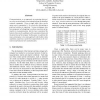Free Online Productivity Tools
i2Speak
i2Symbol
i2OCR
iTex2Img
iWeb2Print
iWeb2Shot
i2Type
iPdf2Split
iPdf2Merge
i2Bopomofo
i2Arabic
i2Style
i2Image
i2PDF
iLatex2Rtf
Sci2ools
IEEECIT
2006
IEEE
2006
IEEE
Towards Balancing Data Usefulness and Privacy Protection in K-Anonymisation
K-anonymisation, as an approach to protecting data privacy, has received much recent attention from the database research community. Given a single table, there can be many ways to anonymise it. So criteria for determining a preferred solution is important. Various techniques have been proposed, all attempting to achieve some form of optimality in k-anonymisation, but few have considered the balance between the usefulness of the anonymised data and the protection of the original. In this paper, we address this issue and propose a two-step approach which allows data usefulness and privacy protection requirements to be considered and balanced in k-anonymisation.
Data Privacy | Database Research Community | IEEECIT 2006 | Information Technology | Privacy Protection Requirements |
Related Content
| Added | 11 Jun 2010 |
| Updated | 11 Jun 2010 |
| Type | Conference |
| Year | 2006 |
| Where | IEEECIT |
| Authors | Grigorios Loukides, Jianhua Shao |
Comments (0)

